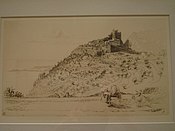Èze
Èze | |
|---|---|
 | |
| Coordinates: 43°43′43″N 7°21′42″E / 43.7286°N 7.3617°E | |
| Country | France |
| Region | Provence-Alpes-Côte d'Azur |
| Department | Alpes-Maritimes |
| Arrondissement | Nice |
| Canton | Beausoleil |
| Intercommunality | Métropole Nice Côte d'Azur |
| Government | |
| • Mayor (2008–2014) | Stéphane Cherki |
Area 1 | 9.47 km2 (3.66 sq mi) |
| Population (2022)[1] | 2,155 |
| • Density | 230/km2 (590/sq mi) |
| Time zone | UTC+01:00 (CET) |
| • Summer (DST) | UTC+02:00 (CEST) |
| INSEE/Postal code | 06059 /06360 |
| Elevation | 0–700 m (0–2,297 ft) |
| 1 French Land Register data, which excludes lakes, ponds, glaciers > 1 km2 (0.386 sq mi or 247 acres) and river estuaries. | |
Èze (French pronunciation: [ɛːz], Template:Lang-it, Template:Lang-oc) is a commune in the Alpes-Maritimes department in southeastern France, approximately 12.5 kilometres from the city of Nice.
History

The area surrounding Èze was first populated around 2000 BC as a commune situated near Mount Bastide. The earliest occurrence of the name "Èze" can be found in the maritime books of Antonin as a bay called the St. Laurent of Èze. A hoard of ancient Greek silver phialae dating from the 3rd century BC was found in Èze in the late nineteenth century and is now part of the British Museum's collection.[2] The area was subsequently occupied by not only the Romans but also the Moors, who held the area for approximately 80 years until they were driven out by William of Provence in 973.
By 1388 Èze fell under the jurisdiction of the House of Savoy, who built up the town as a fortified stronghold because of its proximity to Nice. The history of Èze became turbulent several times in the next few centuries as French and Turkish troops seized the village under orders from Hayreddin Barbarossa in 1543, and Louis XIV destroyed the walls surrounding the city in 1706 in the war of the Spanish succession. Finally in April 1860, Èze was designated as part of France by unanimous decision by the people of Èze.
Èze has been described as an “eagle's nest” because of its location overlooking a high cliff 427 metres (1,401 ft) above sea level on the French Mediterranean. It is so high that the light ochre church within (Notre Dame de l’Assomption built in 1764) can be seen from afar. An Egyptian cross inside the church suggests the village's ancient roots, when the Phoenicians erected a temple there to honour the goddess Isis.
Traditionally, the territory of the Principality of Monaco was considered to begin in the Èze village (outskirts of Nice), running along the Mediterranean coast to Menton, on the present Italian border.
Geography
The commune is located on the French Riviera, extending from the Mediterranean Sea (Èze-sur-Mer) to the hilltop with a medieval village (Èze-Village). Saint-Laurent-d'Eze connects these villages.
Population
The inhabitants are called Ézasques.
| Year | Pop. | ±% |
|---|---|---|
| 1982 | 2,063 | — |
| 1990 | 2,446 | +18.6% |
| 1999 | 2,509 | +2.6% |
| 2008 | 2,961 | +18.0% |
Tourism
Èze, renowned tourist site on the French Riviera, is famous worldwide for the view of the sea from its hill top. Its Jardin botanique d'Èze is known for its collection of cacti and succulents, as well as its panoramic views. Walt Disney spent a significant amount of time in Èze.[3]

The oldest building in the village is the Chapelle de la Sainte Croix and dates back to 1306. Members of the lay order of the White Penitents of Èze, in charge of giving assistance to plague victims, would hold their meetings there. The shape of the bell-turret is an indication that the village once belonged to the Republic of Genoa.
The small medieval village is famous for its beauty and charm. Its many shops, art galleries, hotels and restaurants attract a large number of tourists and honeymooners. As a result, Èze has become dubbed by some a village-musée, a "museum village", as few residents of local origin live here. From Èze there are gorgeous views of the Mediterranean Sea. Èze Village can be reached by train from Nice via train station Èze-sur-Mer or by bus from Nice. Close to the train station is a bus stop for buses bringing tourists to Eze Village.

The motto of the village is the phrase Isis Moriendo Renascor (meaning "In death I am Reborn") and its emblem is a phoenix perched on a bone.
The local dialect (nearly extinct) is similar to the Monégasque language of the nearby Principality of Monaco, and is related to Ligurian but with some influences from the Occitan language.
Èze is one of sixteen villages grouped together by the Métropole Nice Côte d'Azur tourist department as the Route des Villages Perchés (Route of Perched Villages). The others are: Aspremont, Carros, Castagniers, Coaraze, Colomars, Duranus, Falicon, La Gaude, Lantosque, Levens, La Roquette-sur-Var, Saint-Blaise, Saint-Jeannet, Tourrette-Levens and Utelle.[4]

See also
References
- ^ "Populations de référence 2022" (in French). The National Institute of Statistics and Economic Studies. 19 December 2024.
- ^ British Museum Collection
- ^ Tourist Office of Eze - Chateau de la Chevre d'Or
- ^ "The route of perched villages" (PDF). Métropole Nice Côte d'Azur. 2013.






